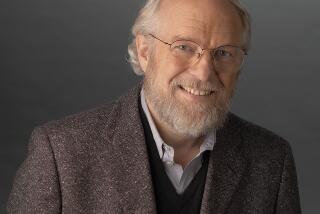Obituaries - Oct. 16, 1999
- Share via
Frederick Belen; Post Office Innovator
Frederick C. Belen, 85, a former U.S. postal official who spurred automation of the post office. Belen was deputy postmaster general during the Lyndon Johnson administration when he helped launch postal automation, including the use of ZIP Code numbers. He also helped set up a network of regional distribution centers to improve mail delivery. Before becoming deputy postmaster, Belen was the assistant postmaster, in charge of the daily operation of 35,000 post offices. In 1963 he was awarded the first Benjamin Franklin Medal for improving postal economy and efficiency. A native of Lansing, Mich., he served in a variety of posts in Washington, including chief counsel to the House Post Office and Civil Service Committee. After leaving the Postal Service, Belen went into private law practice, specializing in legislative and postal issues. On Wednesday in Arlington, Va., of Parkinson’s disease.
Arnold Court; Climatologist
Arnold Court, 85, a climatologist whose research advanced understanding of West Coast hurricanes and led to more accurate methods of measuring rain and snowfall. Court, a professor emeritus of geography at Cal State Northridge, studied climate conditions for 60 years and was frequently consulted by weathercasters and government scientists about meteorological trends, from Santa Ana winds to El Nino. Early in his career, as chief meteorologist for the U.S. Antarctic Service, Court helped to establish a weather station at the South Pole and produced some of the first studies of the Antarctic stratosphere. He was awarded a special congressional medal for his Antarctic service in 1943. Later in his career he was known for his research on upper-air meteorology and hydrology. By studying the placement of meteorological instruments, he also devised more accurate methods for measuring rainfall and snowfall that were adopted by government forecasters at the National Weather Service, the Army Corps of Engineers and the U.S. Geological Survey. In the 1960s and ‘70s he developed new data supporting the prevalence of West Coast hurricanes. Court, who taught at Northridge from 1962 to 1985, was a life member of the American Geophysical Union and a fellow of the American Meteorological Society and the American Assn. for the Advancement of Science. A longtime Northridge resident, he contributed many articles to professional journals and was the editor of the 1968 text “Eclectic Climatology.” On Sept. 13 in Denver of complications of emphysema.
J. Franklin Hyde; Fiber-Optics Pioneer
J. Franklin Hyde, 96, a chemist whose discoveries made fiber-optic technology possible. Hyde was an organic chemist for Corning Glass Works in Corning, N.Y., in 1934 when he developed a practical way to produce in bulk a very pure type of glass called fused silica. Before Hyde’s discovery, scientists had tried to make fused silica by melting quartz crystals, but that required heating the material to more than 3,000 degrees Fahrenheit; once molten, the material could not be easily shaped. Hyde’s advance involved a vapor-to-solid method known as frame hydrolysis, in which silicon and oxygen, the basic raw materials, were heated by running a volatile gas called silicon tetrachloride through an oxygen flame. The ultra-pure vapors formed a fine, glassy powder of silicon dioxide that could be shaped like clay. His method of producing fused silica found its first practical application during World War II in a type of radar used to detect Japanese warships. Today, fused silica glass fibers are used to transmit laser beams in fiber-optics. Optical fiber, invented by three Corning scientists in the early 1970s, is now Corning Inc.’s biggest business. Hyde’s method of making the special glass has also found applications in spaceship windows, computer chip technology and telescopes.
In an interview last year, Hyde said he was not surprised by the versatility of the “beautiful and useful material” he helped to develop. He held about 120 patents, including one for his method of producing fused silica, and was elected to the Plastics Hall of Fame in 1975. On Monday at his home on Marco Island off the Florida coast.
More to Read
Sign up for Essential California
The most important California stories and recommendations in your inbox every morning.
You may occasionally receive promotional content from the Los Angeles Times.













